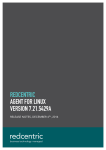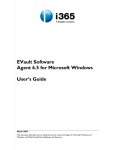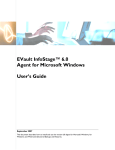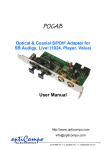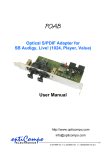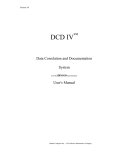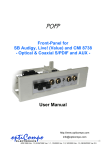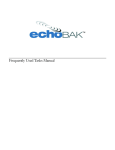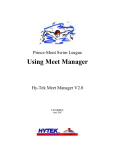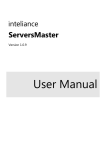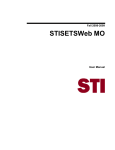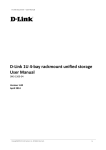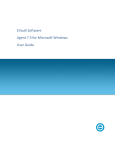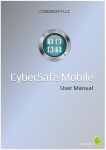Download MBS Agent Agent for Linux Version 6.72.3129 Release
Transcript
MBS Agent Agent for Linux Version 6.72.3129 Release Notes 1 Agent for Linux Version 6.72.3129 Release Notes, August 19th, 2010 1 OVERVIEW This document contains release notes for the latest release of the MBS Software Agent 6.72 for Linux. This release is only supported with Director (Vault) versions 5.53, 6.04a, 6.21a and later. This release is only supported with Windows Agent Console version 6.74 and Remote Agent Console version 6.72a. 'VVAgent' is the Agent program for Windows Agent Console. 'buagent' is the Agent program for Remote Agent Console. 'VV' is a command-line program. You can use it to perform such Jobs as backups, restores, and synchronize operations. 1.1 Release History and Changes August 19th, 2010 - First release, version 6.72.3129 2 FEATURES The Agent is a 32-bit binary and is supported on x86 as well as x64 processors with the appropriate 32-bit compatibility libraries installed for your Linux 2.6 distribution. See section 5.1 for specific package version requirements. Extended attributes: The Agent can now back up and restore extended attributes on file systems that support them. The documentation for your distribution will indicate the file system formats that support these attributes. The Agent will always back up and restore system and security namespace attributes. User namespace attributes can only be protected if they are enabled on the mounted file system. This is a Linux kernel restriction. NFS support for ACLs and extended attributes: NFS does not export extended attributes from remote file systems. On Linux NFSv3 clients, remote file system ACLs will be presented as standard Linux ACLs if possible. NFSv4 clients will present remote file system ACLs as native NFSv4 ACLs, but they will be protected by the Agent as extended attributes. Changes in Restoring to an Alternate Location behavior: For Agent versions 6.72 and above, the Preserve folder structure checkbox has been removed from the Restore Wizard. If you have selected your restore data using the recursive option, the child directory structure is restored recursively from the selection point. 2 This includes all sub-folders and the data they contain. The Parent folder is not restored. Parent folders can be created manually within the restore location if desired. The restore selection can then be directed to the re-created Parent directory. Alternatively, from within the restore wizard, the user can specify an alternative path adding the Parent folder and the Agent will create it automatically. Files and data that are not desired for the restore can be manually excluded from the restore Job. Force reseed through CLI: Delta recreation allows you to rebuild a Delta file through Job synchronization. You can use the /forcereseed option to force a reseed in case of a Delta recreation failure. Longer Job names: Job names can now be up to 30 characters in length. 3 FIXES In previous versions, successfully installed and registered Agents sometimes displayed as offline in console views. This behavior has been corrected. (18964) In previous versions, the Agent did not apply original time stamps to restored directories unless the directories were empty. This behavior has been corrected. (14768/14770) The Agent sometimes left idle processes after backups. This has been fixed in this release. (12381/11332) Restoring to an alternate location failed when the length of the alternate location path name plus the length of the original path name was greater than 1024 characters. This behavior has been corrected. (4089) 4 KNOWN ISSUES When performing a complete system restore (DR), you need to ensure there is ample disk space for the creation of large restore logs from our Agent and other possible logging or auditing from the operating system. Using file level logging on a system containing a large file system can generate a large log, which can potentially fill up the available or allocated disk space. If the logs are on the same partition as the root file system, this may prevent the OS from booting. (19353) An NFS backup Job for a mounted file system will fail if the NFS mount is disconnected at run time. The error messages for this failure do not explain that the problem is related to NFS. (19215) The /selinux directory is not intended to be backed up and the Agent does not currently exclude it from backups. Restoring this directory in place will cause warnings to show in the restore log and the SELinux logs may show warnings as well. You are recommended to exclude the /selinux folder from your backups or not include it in your restores. (19177) If you enable SELinux, some extended attributes may fail to restore when you restore from another computer. (19139) 3 When you restore a very large number of files to an alternate location, you may run out of inodes for the file system. This hangs the restore process. You must kill the VV process, and defunct processes may remain. Truncated restore logs may also result. The logs will indicate that there is no space left on the device, but this might not be true. Because each file consumes an inode, you cannot restore additional files (regardless of how much space is available). Recommendation: Allocate more inodes for the destination file system. (18967) The command-line log viewer, xlogcat, uses the default language that you select during installation unless the LANG environment variable indicates a different supported language. For example, if German (de-DE) is your selected language, but your LANG value specifies U.S. English (LANG=en_US.utf8), xlogcat will display the log in English. You can override this using the "-l" (lowercase L) command-line parameter, or by adjusting the LANG variable. (18941) Email notification regarding the success/failure of restore Jobs has been disabled for this release. (17498, 17459) For a backup or restore task on an NFS system to succeed, you need to have proper permissions to read, write, and create files and directories on the mounted Network File System. This includes the remote system allowing operations for an anonymous user. A good test is to try it from the command line first. If you cannot read/write/create files or directories on NFS manually, the Agent backup and restore will also not work. This issue applies to all Linux platforms. Linux systems may be configured with strong firewall settings (IP tables). These settings may block communication between the Agent and Web or Windows Agent Console. The following ports are used by default for the Agent: * 808 (inbound) - VVAgent control by Windows Agent Console * 8086, 8087 (outbound) - buagent registration and control by Remote Agent Console * 25 (outbound) - email notification * 2546 (outbound) - VV backup, restore, and synchronization with the Director (Vault) To allow management of the Agent by Windows Agent Console, you would need to open the firewall with a rule similar to this: iptables --append <chain-name> -p tcp -m tcp --dport 808 --syn -j --ACCEPT This rule can be made permanent in the normal way for your distribution. Certain file systems and directories are excluded from backups. These include the /dev (device) directory (including the devpts file system at /dev/pts), /boot directory, /var/run directory, and the proc file system (usually at /proc). In Linux kernel version 2.6, there is now the sysfs file system to represent the system hardware devices and drivers (usually at /sys). This is also excluded from backups. Note: On a complete system backup, /dev and /proc directories are NOT backed up. 4 The Linux Agent only protects these locations under their default names. These files must be restored to an alternative location and replaced manually if necessary, as automatic replacement may leave the operating system in an unusable state. When restoring Linux system files, the boot loader should be reconfigured to find the restored operating system files and kernel in their current positions on the hard drive. When using GNU GRUB (http://www.gnu.org/software/grub/), follow the instructions from the GRUB user manual for installing GRUB natively: http://www.gnu.org/software/grub/manual/grub.html#Installation For other boot loaders, refer to the manual provided by your vendor. By default, chkconfig does not include VVAgent in the list of services that it manages. If you add VVAgent to chkconfig, the default run levels become 3 and 5. Recommendation: Use 3 and 5 as your default run levels for starting the VVAgent script. (8321) You cannot browse an NFS mount when you attempt to restore an NFS backup to an alternate location. (8226) It is possible to successfully back up a large file that fails to restore to the same location. As a workaround, change the user limits that relate to the file system. (8262) You may see restore errors such as these: UTIL-E-8242 Thread synchronization error. Failed to set the semaphore to the signaled state. UTIL-E-8235 O/S error 34, message: Numerical result out of range. REST-F-4110 Job failed to complete. The semaphore limit on the Linux system may be set too low. You can increase the "max ops per semop call" value from the default of 32 to 100. To modify this kernel parameter, edit the /etc/sysctl.conf file. If the file does not exist, create it, and add this line: kernel.sem=250 32000 100 128 To make this parameter take effect, restart the machine. 5 INSTALLATION NOTES 5.1 Installation Requirements Installation requirements for the Agent program. Hardware ******** CPU: 32-bit x86, 64-bit x86_64, or compatible processor Note: Meet or exceed the hardware requirements of your operating system. RAM: Minimum of 2 GB Disk space: The Agent requires at least 100 MB of free space for a new (fresh) installation. An upgrade may require more. If there is not enough disk space, the system will issue a message. 5 Software ******** - Director version 5.53, 6.04a, 6.21a or greater - Windows Agent Console version 6.74 or Remote Agent Console version 6.72a - A Linux 2.6 (kernel 2.6.9 or later) distribution for x86 or x86_64 processors The distribution must have the following packages installed: - glibc 2.3.4 or later - libstdc++ 3.4.6 or later - libgcc 3.4.6 or later - libattr 2.4.16 or later - libacl 2.2.23 or later Linux 64-bit distributions must have the appropriate 32-bit compatibility libraries installed. This Agent is supported on: - SUSE Linux Enterprise Server 10 (up to Update 1 SP 3) - SUSE Linux Enterprise Desktop 10 (up to Update 1 SP 3) - SUSE Linux Enterprise Server 11 (up to SP 1) - SUSE Linux Enterprise Desktop 11 (up to SP 1) - Red Hat Linux Enterprise / Advanced Server 4 (up to Update 8) - Red Hat Linux Enterprise / Advanced Server 5 (up to Update 5) - Red Hat Linux Enterprise / Advanced Platform 4 (up to Update 8) - Red Hat Linux Enterprise / Advanced Platform 5 (up to Update 5) - CentOS 4 (up to 4.8) - CentOS 5 (up to 5.5) Note: You may see core dumps related to semaphore limits on the system. You can change the semaphore limits through the following kernel configuration parameters. Parameter / Recommended Minimum Limit semmni / 128 Defines the number of semaphore identifiers in the kernel. This is the maximum number of unique semaphore sets that can be active at any one time. semmns / 32000 Defines the maximum number of semaphores in the system. User processes include jobbed processes, plus all other semaphores required by other software. semmsl / 250 Defines the maximum number of semaphores per identifier list. semopm / 100 Controls the number of semaphore operations that can be performed per semop system call. 5.2 Procedure for Installing/Uninstalling 6 Please refer to the Agent for Linux User's Guide. INCLUDED APPLICATION FILE LIST The Agent kit installs the following binary files. Binary File md5sum Value AgtUpgd 4bb29f4ce07745d824ad0e4d6575e333 buagent 39ced3345cc5a6d75aade2279a97c7d8 libcrypto.so.0.9.8 ed00756e5f22a761fa95e4ecca47cdeb libssl.so.0.9.8 feb6f7e517fadcb92113e461dc220af2 VV 5a695244ce62ad31543cce8ecf6f1ea VVAgent 26cfd534017355d2a18ba84cc97edcae xlogcat 5934575c3d013d37dfff40562a8897c9 xlogmore dad783c2caa1fadad38c9389e8fa6c8f To obtain md5sum values, issue the following commands. These commands are examples based on an Agent that has been installed in the default location (i.e., /opt/BUAgent). cd /opt/BUAgent md5sum * 5.3 Configuration Each machine to be backed up must have the Agent software installed and subsequently configured with: * MBS Windows Agent Console version 6.74 or 6.72a MBS Remote Agent Console version See the Agent Console documentation for detailed information.








